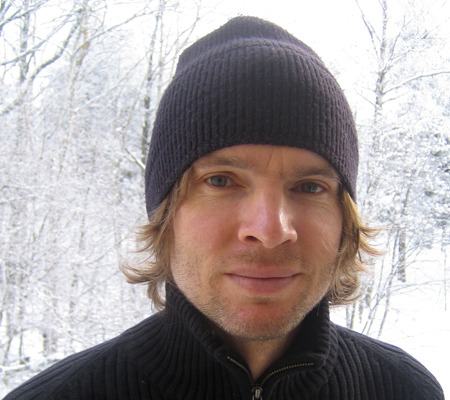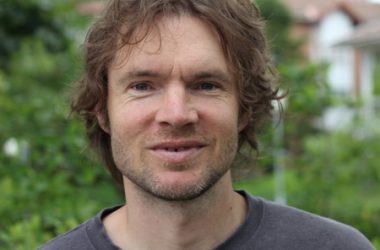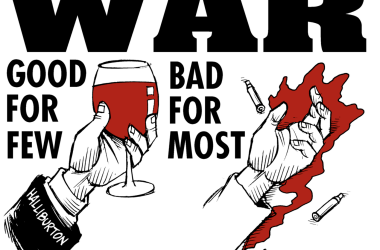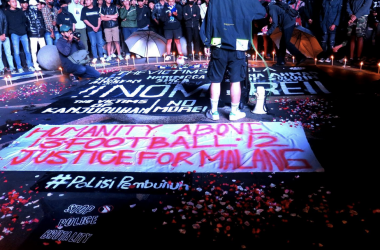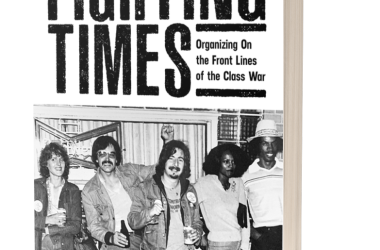By Gabriel Kuhn
A review of Andrew Cornell’s Unruly Equality: U.S. Anarchism in the 20th Century (Oakland: University of California Press, 2016). Also published on AAP.
In the “Acknowledgments” of Unruly Equality: U.S. Anarchism in the 20th Century, Andrew Cornell writes that the idea for his book came from the desire to “connect the dots between Emma Goldman and [the anarcho-punk band] Crass” (p. xi). Eventually, he settled for a slightly narrower time frame, namely 1916-1972 (Crass only formed in 1977), because “it was during the middle part of the twentieth century that the priorities, tactics, and base of supporters that define contemporary anarchism first came into focus” (p. 3). By choosing this path, Cornell essentially fills the gap between so-called classical anarchism and the reemergence of anarchism as a recognized political movement in the 1960s. The approach reminds me of an account I read about communist organizing in the U.S. during some of the movement’s most difficult years, that is, from the 1940s to the early 1960s. The author – whose name I am as unable to recall as the account’s title – claimed that instead of the period having been bereft of all communist activity, it simply happened underground, preparing the seemingly surprising arrival of the New Communist Movement at the end of the 1960s. In short, while the flows of political movements are undeniably their sexiest stages, it is both unfair and unbeneficial to conclude that nothing happens during the ebbs. In fact, without hundreds (thousands) of people committed to keeping movements alive when the going gets tough and preparing for better times to come, the arrival of such times is highly unlikely, if not outright impossible. To illustrate this by presenting a “prehistory of contemporary U.S. anarchism” (p. 280) is one of the great achievements of Cornell’s book.
The history
In eight chapters, Cornell leads us from the Red and Black Scare of the late 1910s to the nonviolent anarchist groups of the 1940s to the New Left of the 1970s. In addition, he provides an “Epilogue” that covers the period “From the 1970s to Occupy Wall Street”, satisfying the curiosity of all readers wondering about “what happened next”.
It should be noted that Cornell explicitly situates anarchism within the left and defines it as “social anarchism” (p. 7). This is of importance not least for European readers who have often come to associate U.S. anarchism with “post-leftist” or “anti-leftist” tendencies represented by anarcho-primitivism or the popular CrimethInc. project. (During my first visit to the London Anarchist Bookfair, I was tabling next to a the well-established British anarchist organization. When I mentioned that I had spent several years in the U.S., I was matter-of-factly reminded that “all American anarchists are idiots”.) However, Cornell does not leave out anarchism’s important contributions to the arts, popular culture, and everyday life – in fact, these make up a big part of the book. Cornell even looks at spiritual currents within U.S. anarchism, from the Catholic Worker Movement to the embrace of Buddhism in the countercultural milieu of the 1960s.
Unruly Equality fulfills the two criteria that make “definite volumes”: it fills a gap and it does this remarkably well. The book is meticulously researched, well structured, and convincingly narrated. It is also full of anecdotes that evoke intriguing images: of anarchist agitators hitchhiking across the United States in the 1920s, of Italian anarchists being described by comrades with a more organizational outlook as “do[ing] things spontaneously, when there is a call for it, in the eleventh hour of its need” (p. 106), or of destitute workers gathering in anarchist-inspired communes such as the Sunrise Co-operative Farm Community.
One of the chapters I found most interesting was “Anarchism and the Black Freedom Movement, 1955-1964”. Not only does it cover a subject matter I’ve rarely seen treated before, but it also includes important discussions on the notions of violence and nonviolence in political resistance and on anti-colonial and national liberation struggles. Furthermore, it introduces often neglected figures such as Bayard Rustin. Finally, it raises key questions for anarchist organizing by pointing to the state’s ambiguous role for progressive social movements: “In the momentous desegregation and decolonization fights of the mid-twentieth century, the anarchist belief that government was inherently a corrupting force of domination chaffed against groups of historically oppressed people marshaling the resources and authority of government to blunt the coercive, often deadly, force of other centers of power, be they racist mobs or foreign corporations backed by imperialist governments.” (p. 212)
“Interpretive comments”
On the one hand, it seems unfair to start quibbling over details with respect to a work as accomplished as Cornell’s. On the other hand, reviews without any critical engagement easily veer toward the forgettable. The following comments ought to be read with this in mind.
Cornell’s insistence that anarchism is more influential than many people think is important. He stresses “the vital contributions anarchists made … in combating fascism, remaking adolescent education, developing cooperative enterprises, resisting militarism, confronting racial segregation, or inventing powerful new artistic and literary forms that have saved the lives and emotional well-being of countless misfits, nonconformists, and outraged souls.” (p. 289) I feel, however, that Cornell could have focused more on the problems attached to this, namely that the anarchist origins of many struggles are forgotten once they have arrived in what German-speakers call “the middle of society”, where all revolutionary aspects are erased, leaving behind little more than commodities on “alternative” markets or selling points for liberal legislators.
In his “Conclusion”, Cornell shares some “interpretive comments” with respect to the history he has documented. Among them is the following: “In the twentieth century, anarchists were either uninterested or unable to systematize their perspective, and they have not excelled at engaging ideological opponents in an effort to win the war of ideas.” Cornell offers an explanation for this: “The tendency to criticize broadly, but to inconsistently refine and defend positions, is likely related to the scant resources and the institutional marginalization that most anarchists coped with throughout the period under study.” (p. 286) I think this he is letting anarchists off too easy here. The problem of not systematizing an anarchist perspective and of not engaging ideological opponents runs deeper than a lack of resources and institutional marginalization. Matthew Wilson discusses this in his book Rules Without Rulers, also reviewed on this blog. There are deeply-rooted problems in the anarchist movement – self-centeredness and self-righteousness, dogmatism and sectarianism, individualism and naiveté – that cannot be explained by exterior circumstances but require serious soul-searching and introspection.
Another observation of Cornell’s I don’t quite agree with is that “anarchist ideas have proven even more influential in Europe, Latin America, and other parts of the world” (p. 1). I don’t know about Latin America, but in many European countries, the Marxist left has remained significantly stronger than in the U.S. and never allowed anarchism to become “‘the pole that everyone revolves around’, much as Marxism was in the ‘60s”, as a Village Voice article claimed in 2002. And while it is not the place here to explore in depth some of the specific international examples that Cornell cites – the involvement of anarchists in the Japanese anti-nuclear movement, anarchist black blocs during the 2011 uprising in Egypt, and the Bookchin-inspired “democratic confederalism” of Rojava (Syrian Kurdistan) – I feel that they must not be overstated for reasons ranging from a sheer lack of numbers to questionable applications of anarchist principles. Ironically, Cornell might have pointed to these international examples to avoid dishing up an anarchist version of “American exceptionalism”, even though, in this case, I think that the role anarchism has played in the U.S. in recent decades has been fairly exceptional.
In fact, reading Cornell’s book made me think that a study tracing the global influence of U.S. anarchism would be of great interest. Especially since the end of World War II, with the U.S. establishing global cultural hegemony and English becoming the undisputed international language, the reach of U.S. radicalism has also expanded. For example, many nonviolent anarchists in Europe have been strongly influenced by the Student Nonviolent Coordinating Committee (SNCC), the beatniks are still celebrated worldwide, and authors such as Murray Bookchin, Noam Chomsky, and, to add a more recent example, David Graeber are among the most widely read anarchists.
Let us return to Cornell’s “Introduction” one more time: to further strengthen his case about anarchism’s contemporary influence, he refers to what Chris Dixon has called a broader “anti-authoritarian current” in the book Another Politics: Talking across Today’s Transformative Movements. I think that this is not without problems. There are numerous examples for anarchist influences on broader social phenomena, but they also include “horizontal” business ventures and “autonomous” organizing among the far right. I understand that these examples are a far cry from what Cornell (or Dixon) have in mind, but I’m just trying to stress that anarchism influencing something and anarchism manifesting itself are not the same things. I believe we are better off focusing on explicitly anarchist politics if we try to assess the good that anarchism can do.
One final comment: Almost in passing, Cornell makes a very interesting point about neoliberalism and postscarcity. The latter notion has had a significant influence on anarchist thinking since a collection of Murray Bookchin essays was published under the title Post-Scarcity Anarchism in 1971. Cornell rightfully contends that proponents of an anarchist society made possible by both technological and social developments in the industrialized world were “caught off guard by the onset of neoliberalism” (p. 287), which threatened much of what was taken for granted in the 1970s, especially concessions made to the working class through the social welfare state. Today, the situation has drastically changed, which requires thorough discussion in order to develop timely anarchist strategies.
The end
As far as the future prospects of anarchism are concerned, Cornell doesn’t excel in optimism. After declaring that “anarchism remains a practice that today informs movements for justice and dignity throughout the world”, he admits that “after working on this book for more than a decade, I am not convinced that anarchism possesses all the tools necessary to achieve these far-reaching goals” (p. 290) The book’s final sentence reads: “It remains to be seen what egalitarians will do with the wealth of experience and insight anarchists and their allies accumulated throughout the twentieth century and the years that have followed.” (p. 300) We can only hope for the best.
(January 2017)
More blogs from Gabriel | Back to Gabriel Kuhn’s Author Page

